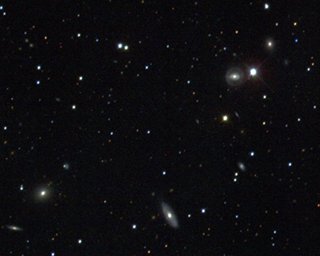SDSS First Light: A small section of the first-light image obtained by the Sloan Digital Sky Survey on the night of May 27-28, 1998. The overall image is over 5,000 times larger than this small piece of the constellation Serpens. The photo was assembled from digital scans taken through separate filters. (The individual colors provide valuable information for identifying the objects.) It also shows stars in our own Galaxy (the brighter ones are recognizable by the cross pattern), a half-dozen distant galaxies near enough to show morphological features like disks and rings, and many fainter and farther galaxies, distinguished from stars by their slightly fuzzy appearance.
Credit: Sloan Digital Sky Survey
SDSS had a big camera for direct imaging and multiple spectrographs. The spectrographs are still in operation today, but the camera was decommissioned in 2009. To determine the galaxies for which we wanted spectra, we imaged one-fourth of the sky with the big camera I mentioned earlier. The images gave us the ability to measure the exact position of the galaxies in two dimensions. We needed the third dimension, the distance, to measure the clustering, the likelihood that you will find a galaxy within a given distance of another galaxy. Distance is important because, for instance, two galaxies may appear next to each other in two dimensions, such as in a photograph, even if one is much further away. The third dimension is obtained by taking a spectrum of the galaxy and using the redshift derived from the spectrum to measure the distance.
To study clustering you want to measure many galaxies; if you want to observe 400 galaxies with a normal telescope, it could take 400 hours. Sloan’s telescope allows for the observation of 400 galaxies at once, so it would take 1 hour. With a normal telescope, the survey would take up to 2000 years. With Sloan, the survey only took 8 years, 3 more than the proposed 5, but still many years shorter than performing the survey with a normal telescope.
The telescope had the potential to observe 640 objects simultaneously; to the nominal 400 galaxies on each plate, we added 100 QSOs, 50 stars, and various calibration objects. The number of objects on each plate was determined by the number of candidates in a particular field, which varies. The calibration objects were selected to be objects of known brightness to give us a reference point for measuring fluxes with high precision even when cloudiness, for example, causes a dimming in the sky.
It took a couple of years to learn what the selection criteria would be for guessing that an object was going to be a quasar, but eventually we were able to apply the technique we developed for identifying quasars and found all of the quasars and could be detected this way in the one-quarter of the sky that was surveyed. With regard to the stars, there are many more than 50 stars in the field of view that could be observed in a single exposure. Therefore, we would observe a different kind of star every six months, picking 50 different stars for each plate.
Everything that we had known before was applied to this observation plan and many, many discoveries were made.


